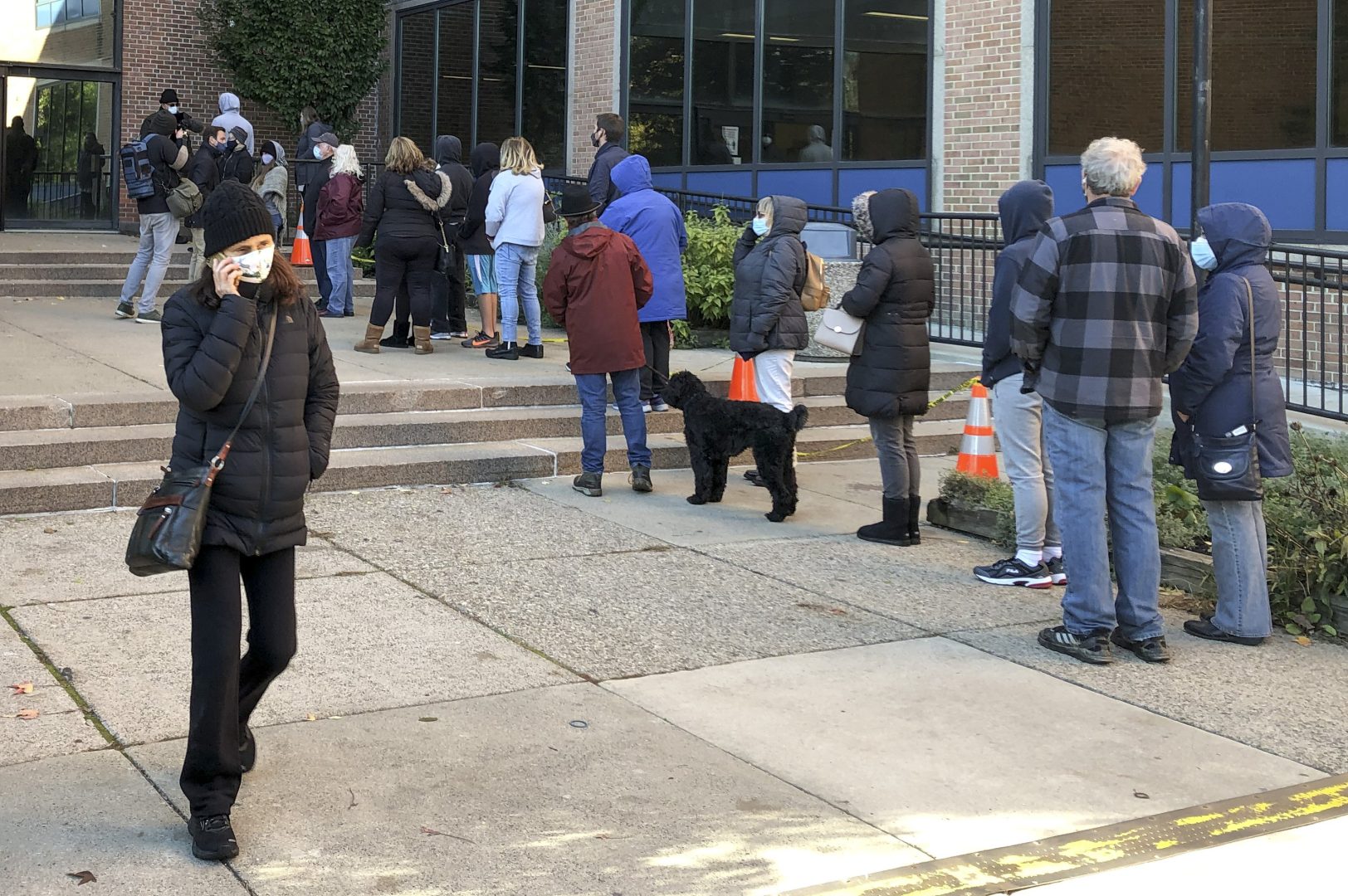
Voters wait in line outside the Bucks county government building in Doylestown, Pa., a suburb of Philadelphia, on Monday, Nov. 2, 2020.
Mike Catalini / AP Photo

Voters wait in line outside the Bucks county government building in Doylestown, Pa., a suburb of Philadelphia, on Monday, Nov. 2, 2020.
Mike Catalini / AP Photo

Mike Catalini / AP Photo
Voters wait in line outside the Bucks county government building in Doylestown, Pa., a suburb of Philadelphia, on Monday, Nov. 2, 2020.
This story was updated to correct a statement from Diana Robinson from Make the Road Pennsylvania about maps submitted by the organization.
A pillar to the Latino narrative in the United States is the search for an opportunity, a chance.
Plans to parcel out Latino voters over the next decade are spurring some to raise the alarm that Latinos will not have a fighting chance to represent their communities – or even have their electoral voice actually heard.
Others are saying all they need is their foot in the door and that new legislative maps give them that opening.
Who gets a say in state politics and who doesn’t is playing out in two of Pennsylvania’s largest cities, no further than an hour apart.
In Allentown, Latino leaders say their power is being effectively divvied up into scraps. And they are plotting to sue the state over district maps set forth by the Legislative Reapportionment Committee.
Just south of there, elected officials and hopefuls in Reading are saying they see a chance for more Latinos to walk the halls of power.
Allentown is a city of 125,845 people, and just over half of them are Latino.
Under the new district plans, the Allentown area is going from two state House seats to three, and from two jagged interlocking Senate districts to two much more uniform ones. What’s causing alarm is not the number or shape of districts, but who lives in them.
While one district becomes more than a third Latino, the other two reduce their numbers. In one, the percentage of Latinos is reduced by more than half.
The outspoken owner of La Mega radio station, Victor Martinez, claims he and other Latino activists are scrambling to either find viable Latino candidates for the new Allentown House seats or challenge the maps in state Supreme Court.

“We have to focus on both because if we focus too much on the action part and not finding candidates, well guess what – petitions are around the corner,” Martinez said this week.
Last week, the Pennsylvania Supreme Court put on hold the deadline for candidate petitions but kept the May 17 primary in place.
Martinez says he is willing to sue the state because he says Latino Democratic congressmen are supporting the maps publicly, even if they have bemoaned them to him privately.
Allentown’s new state House District 132 is not minority-majority, and Latinos make up around 15 percent of the voting age population. In the minority-majority 134 state house district, Latinos make up around 38 percent of the voting age population.
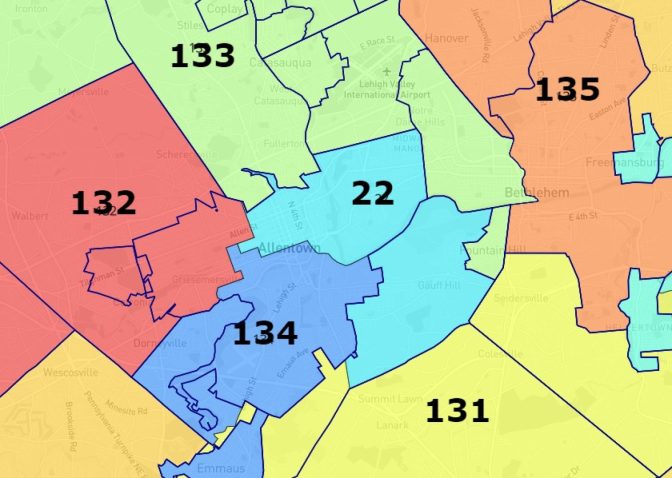
Visual of the new districts via DavesRedistricting.org
Carol Kuniholm is the chair of the non-partisan coalition working to reform the redistricting process, Fair Districts PA.
She said while redistricting in Allentown may result in incumbents campaigning in safer districts, she does not see an obvious basis for legal action to change the newly approved maps.
“But I think people who believe in a government that responds well to communities are disappointed that incumbent protection seems to have been a higher value here than the value of the community’s voice,” Kuniholm said.
The approved maps are in the public sphere and open to legal opposition in the state Supreme Court until March 6.
Voting patterns show that Latino voters do not exclusively vote for Latino candidates. But Martinez noted that people are more likely to show up when they see a candidate that shares their culture and ethnicity.
Martinez pointed to the success of first-time candidate Enid Santiago, who challenged state Rep. Peter Schweyer in 2020. Santiago lost her bid for the 22nd district in a squeaker of an election.
She and Schweyer are now slated to move into House District 134, leaving the 22nd open without an incumbent. That district is 67 percent minority and 53 percent Latino.
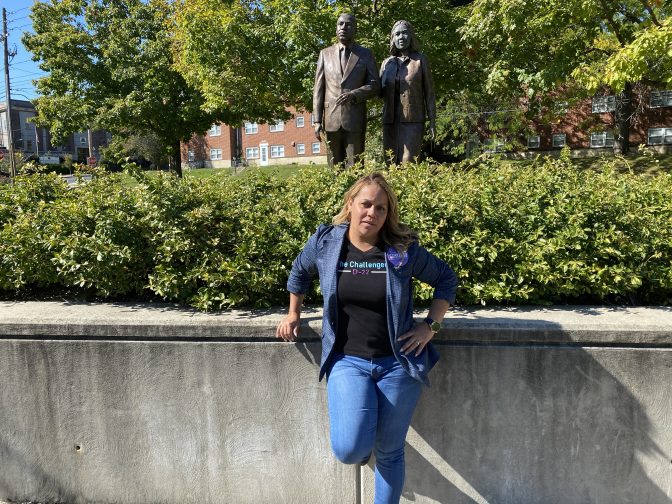
Anthony Orozco / WITF
Enid Santiago says she is worried maps have been drawn to cut out promising candidates. Photo: Anthony Orozco/WITF.
So if Santiago were to run in her new district, she would be campaigning in an area where White voters are the new majority and Latinos make up 38 percent of the voting age population – cut down by 17 percentage points from her last run.
Santiago said she is concerned with the lack of a viable Latino candidate who is ready to jump into a political race. She said she feels that the maps were purposefully drawn to shut out candidates like her and the first Latino mayor in Pennsylvania, Jose Rosado.
The 22nd House district preliminary map included Rosado’s home of Fountain Hill. Rosado announced his candidacy for that seat early this year but no longer qualifies.
Fountain Hill is now in the 133rd district, which is 30 percent minority and 18 percent Latino.
“It’s not even just frustrating, it’s very worrisome to continue to block Latino representation in positions of power when we are the fastest growing minority in the state of Pennsylvania,” Santiago said. “We are over a million strong [in Pennsylvania] and we’re also the majority of the city of Allentown.”
The Legislative Reapportionment Commission has said it drew maps in Latino areas in a way that does not deprive Latinos from electing a candidate of their choice.
Schweyer said he felt the maps approved by the commission are fair and competitive.
“There are a number of opportunities for folks from the Latino communities that absolutely would be exceptional members of the General Assembly and would present really, really attractive candidates,” Schweyer said, pointing to Latino candidates who have been successful in the city.
Over the past 10 years, Allentown has become more Latino, and leadership has reflected that diversity. City Council President Cynthia Mota is of Dominican descent, and recently took over for former council president Julio Guridy, a native of the Dominican Republic.
Mayor Matthew Tuerk, who has Cuban heritage, is only weeks into being the city’s first Latino mayor.
Diana Robinson, civic engagement director at immigrant advocacy group Make The Road Pennsylvania, worked with community members in Latino cities in the Route 222 Corridor to learn more about how redistricting will affect them.
Robinson said she generally finds the maps to be less gerrymandered and more competitive. But how the committee sectioned Allentown area districts waters down Latino voters’ power, she said.
Robinson said members of Make the Road submitted their own map suggestions.
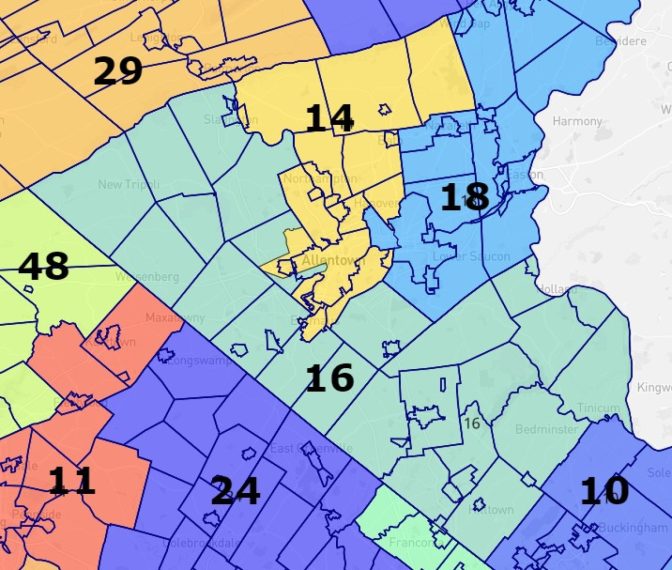
Senate districts of the Lehigh County via DavesRedistricting.org.
Robinson argues splitting the area can potentially mean less resources for constituents of each district.
“In Allentown, in particular, we see they want to split into three districts that we think that dilutes, especially the Latino voter power,” Robinson said.
Robinson says she also would have liked to have seen Reading remain closer to its former makeup, where Latino power was more consolidated.
But people in Reading are signaling that the new maps could shake things up and make it more representative for its expanding Latino population.
Reading’s Senate district remains largely white, with the minority voting age population increasing two percentage points to 39 percent. But a new House district that is nearly half Latino has opened in the city.
Reading and Berks have accomplished firsts that no other county achieved. Currently in office are the area’s first Latino mayor, its first Latino county commissioner and its first Latino state representative.
Democratic State Rep. Manuel Guzman Jr. has been a visible advocate for Reading and Latinos in his first year at the state capital.
Some in the Latino community and in civic groups are calling for more equitable state legislative maps in the areas. But Guzman says he sees opportunity and advantage in Berks – even as his district shifts from urban Latino voters to more suburban and White.
Guzman’s district partially shifts from highly populated row homes in northern Reading that include the most densely Latino census tracts in the state.
The new district lines reach southwestward into Cumru and Shillington, where those demographics are essentially flipped toward White voters and home values are several times that of homes in most of Reading.
Guzman, a freshman legislator recently appointed to the House Appropriations Committee, said the new maps come with challenges but do not prevent Latinos from having a shot.
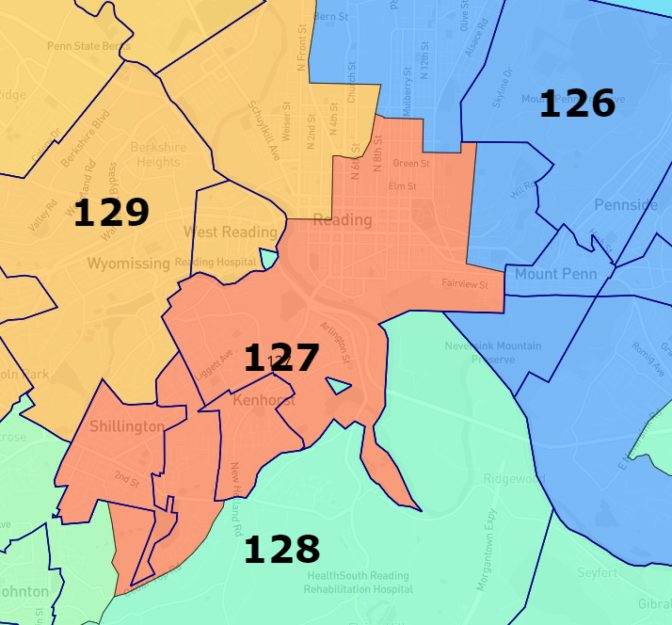
“So, number one, it makes me feel like I’m up for the challenge,” Guzman said. “I feel confident that the work that we’ve been doing over the last year in Reading will be able to reverberate across Berks County.”
But beyond how the change may affect his own future campaigning, Guzman says new district lines appear to give Latinos who have expanded out of the city in the past decade a louder voice in elections by “unpacking” Latino voters out of a single district.
“Over the last 20 years, their voices have been severely diluted, because of the ‘packing’ that has happened within the 127th Legislative District,” Guzman said. “Now that ‘packing’ is being somewhat undone; now it gives those Latinos in Sinking Spring, Wyomissing and Mohnton the opportunity to potentially influence an election.”
Reading City Council Vice President Johanny Cepeda-Freytiz said having a bilingual, young Latino in office like Guzman has helped some people better understand how electoral politics at a state level can directly impact them.
“He does a lot of Facebook Lives, he communicates with the public, he’s always educating, informing, giving people some insight into the work that he does,” Cepeda-Freytiz said. “And I think that gets people excited, because I think part of the reasons why people maybe don’t go out and vote, they don’t realize the work and the responsibility of an elected person.”
Cepeda-Freytiz said she has watched the redistricting process with great interest.
“Reading has so many opportunities, so much potential but oftentimes – and I want to be very real – I feel like we get overlooked,” Cepeda-Freytiz said in between serving patrons at her restaurant, Mi Casa Su Casa in the city’s downtown.
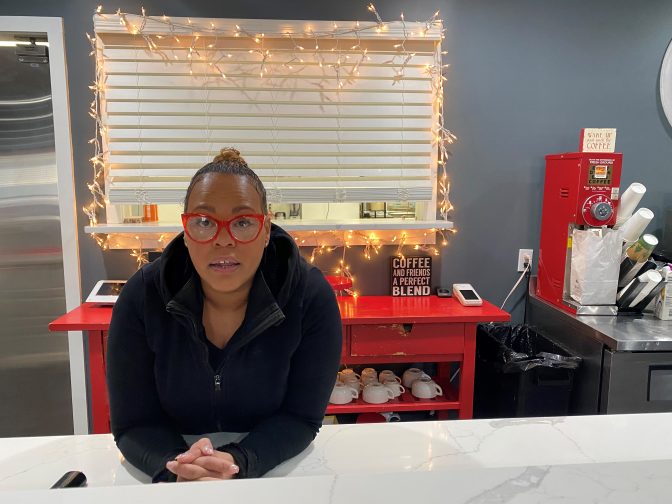
Anthony Orozco / WITF
Reading City Council Vice President Johanny Cepeda-Freytiz talks politics in between serving customers in her downtown restaurant.
Cepeda-Freytiz noted a monumental shift in district lines is happening in the 129th State House district, which will now include her city council district in northwestern Reading.
It encompasses Reading’s sixth city district – where the population is overwhelmingly Black, Latino and Democratic – and spans into West Reading Borough. The borough’s Latino population has jumped from 18 percent to more than a quarter of residents.
The most westward section passes through Wyomissing, an area where half a million-dollar homes are not unusual and White people make up around 85 percent of the community.
The reshaped 129th House district leans much more Democratic (59 percent) and Latino (34 percent).
Giving Latino candidates a fighting chance is important, but not as important as having a candidate who will serve in the best interest of the population, Cepeda-Freytiz said.
“I think we need to continue to break down some barriers and support candidates who have the skill set and experience to carry out certain objectives.” she said. “[We need candidates] to properly make decisions that benefit everyone, not just a select few.”
The 129th State House district in Berks will look completely different from its former composition, reduced to an east-west sliver that is much less red than before and has no incumbent.
“If folks are ready, there’s a seat that is a good race, right there,” Kuniholm said in her analysis of the map.
Reading School Board member Mark Detterline has lived in Guzman’s 127th House district for several years and said he applauds the state representative’s work. With the shifting lines, Detterline now lives in the 129th and said he is working toward a Democratic primary campaign and potentially a general election run.
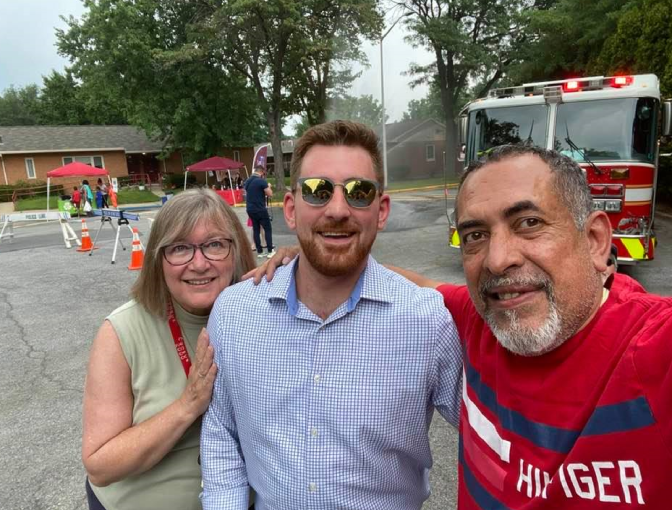
Donna Reed.
Mark Detterline, center, at a community event with Reading City Councilwoman Donna Reed, left, and Mayor Eddie Moran, right.
Detterline is an assistant dean of admissions at Swarthmore College. He said a main reason for him running is to bring in more state money to underfunded school districts such as in Reading, which serves an overwhelmingly Latino student population.
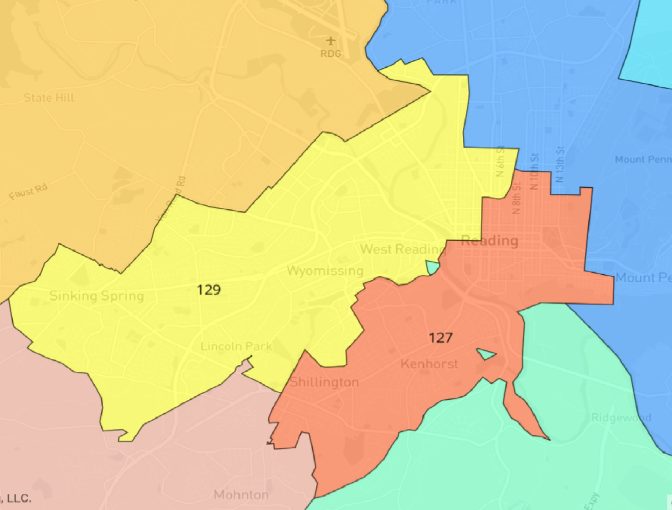
When pondering the push to have more Latino representation at the state level, Detterline said he thinks advocacy for the needs of the city can be done by people outside of the ethnicity, and that Latino lawmakers shouldn’t carry the burden on their own.
“We should definitely try to make the Latino voice heard a little louder in Harrisburg, it shouldn’t be up to a couple of members to be that voice for [all Latinos],” Detterline said. “I think that’s an unfair expectation that we put on Latino politicians.”
Anthony Orozco is part of the “Report for America” program — a national service effort that places journalists in newsrooms across the country to report on under-covered topics and communities.
The days of journalism’s one-way street of simply producing stories for the public have long been over. Now, it’s time to find better ways to interact with you and ensure we meet your high standards of what a credible media organization should be.